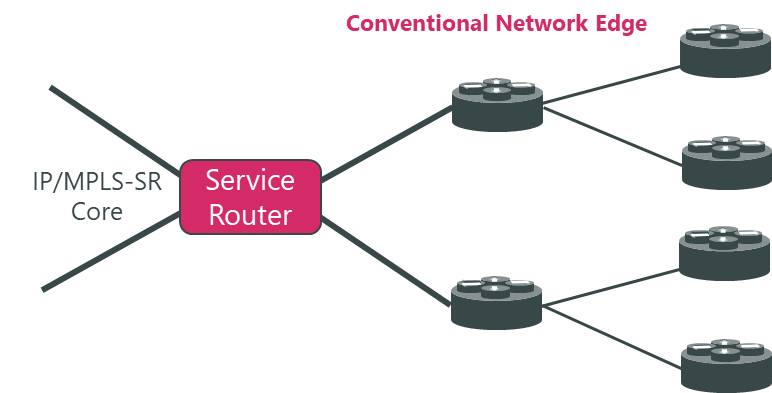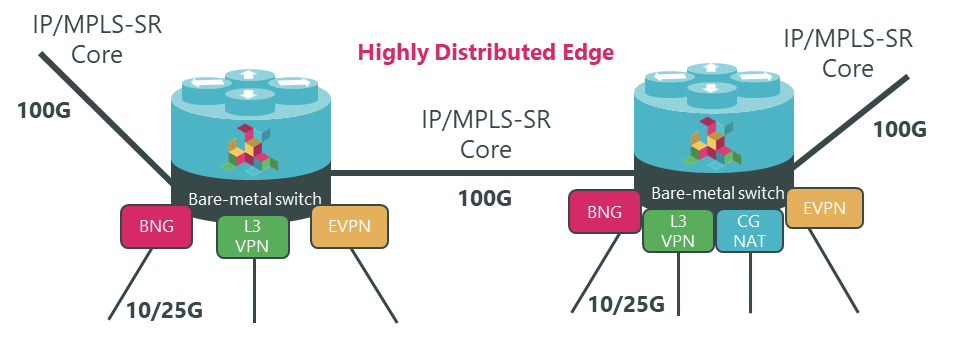Scaling-Down the Edge

Whether you are a small ISP, servicing a low-population area or deploying edge computing, scaling down the network edge can be even more of a challenge than scaling it up. Or perhaps another of phrasing it, is how do you scale it out.
At the network edge, you need to deploy optical transit equipment, as well as deliver a range of IP services, such as L2 and L3VPNs, residential broadband services requiring a BNG (Broadband Network Gateway), and, in some cases, CGNAT (Carrier Grade Network Address Translation).
The traditional approach to building the network edge required either multiple pieces of equipment or large proprietary chassis-based systems - or both! But neither of these approaches scale-down cost-effectively, not to mention their inefficient use of space and power.

So, why is this important?
Smaller service providers, and those expanding into new regions, have to support relatively small initial numbers of customers as they expand their footprint. This often makes it uneconomical to take a ‘build it and they will come’ approach. They need to expand their networks in a way that only adds low incremental cost as they add smaller numbers of connections.
Delivering services in geographies with low population densities brings similar challenges. In this case the problem is compounded because there are never likely to be large numbers of connections in those locations.
And finally, there is the opportunity offered by edge computing. Many applications can benefit from having computing and storage capabilities located closer to the user or client. But the only way to benefit from this is to terminate the access services before the traffic reaches the edge computing infrastructure. By contrast, a highly centralized BNG can be efficient, but the subscriber traffic would need to ‘trombone’ in and out of the central location to reach the edge computing resources, defeating the object. The only way to solve this challenge is to have a more distributed network edge, and that means scaling it down.
How does disaggregation help?
Advances in merchant silicon have led to the availability of low-cost , yet powerful, open switches that can run software from third parties. When running RtBrick’s multiservice edge routing software, these switches can provide L2 and L3 VPN services, a BNG, core routing and CGNAT in a small form-factor. They can also provide transit connectivity when equipped with long-range optics.

For example, switches such as the EdgeCore CSR440 and UfiSpace S9510-28DC provide 800Gbps of throughput in a hardened single RU form factor, and have the capacity to support thousands of residential subscribers, along with L2 and L3 VPN services. If this isn’t sufficient, then more powerful switches, such as the EdgeCore AGR420 and UfiSpace S9600-72XC, can scale to 2.4Tbs of throughput, support tens of thousands of subscribers, and can also perform in-line CGNAT, if its needed.
Combining VPN, subscriber services, core routing and transit on a single, low-cost switch enables the edge to operate at scales that have never been economically viable before. Provisioning services becomes far simpler. It is highly power efficient. And there is no lock-in to a traditional vendor, with your choice of NOS (Network Operating System) independent from your choice of hardware.
And if you have some locations that do need to scale-up, the same disaggregated systems can be built into huge spine-leaf architectures that can support hundreds of thousand of subscribers using the same software and hardware.
When can we expect this to happen?
This is all available today.
A great example of this is German ISP, WOBCOM, who have taken exactly this approach to build a next-generation multiservice edge that delivers transit, Ethernet business services at up to 100Gbps and residential IP services with symmetrical 1Gbps throughput from the same open hardware.
So, whether you need to support a few customers, or are looking to distribute edge computing, the scaled-down network edge has arrived.